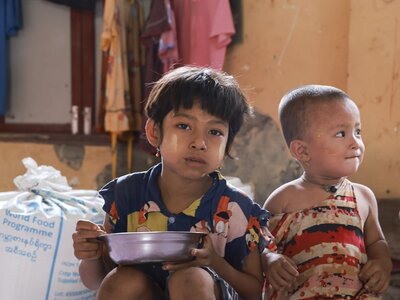Emergency
Myanmar
- 19.9 million
- people in need of humanitarian assistance
- 3.5 million
- people displaced by conflict
- US$155 million
- needed for WFP operations to June 2025
Food insecurity in Myanmar has reached unprecedented levels amid the worst humanitarian crisis in its recent history, affecting 15.2 million people.
A political crisis, conflict, economic downturn, pre-existing poverty and climate-related shocks are all driving the emergency.
Conflict is spreading into new areas, driving displacement at a record scale. Most displaced people are cut off from access to food and often dependent on WFP assistance for survival.
Meanwhile, the country is highly vulnerable to climate-related disasters. Devastating floods in September 2024, caused by Super Typhoon Yagi, have affected more than 1 million people.
The World Food Programme (WFP) responds to sudden-onset emergencies, including the Yagi flood response which targeted 500,000 people.
Despite immense security constraints, impeded humanitarian access and funding challenges, WFP aims to reach 1.6 million of the most vulnerable people in 2025, working primarily with local partners.
WFP urgently needs US$155 million to sustain aid for vulnerable communities until June 2025, and calls on the international community to scale up its support to the people of Myanmar.
What the World Food Programme is doing to respond to the Myanmar emergency
-
Emergency response
-
WFP’s priority is to ensure life-saving assistance reaches communities affected by conflict. Following breakthroughs over the past two years in accessing hard-to-reach locations, WFP has launched emergency food and nutrition programmes in Kayah State, southern Shan State, Bago Region and Sagaing Region for thousands of people.
-
Nutrition
-
WFP provides a comprehensive package of nutrition support to pregnant and breastfeeding women and young children aged between 6 months and 5 years. WFP also provides food and cash-based nutrition support to people living with HIV and TB, and delivers nutrition education and counselling.
-
Resilience
-
In areas with relative stability, WFP is creating livelihood opportunities and improving resilience through projects for the development of community assets such as roads, terrace land, irrigation canals, flood-protection dykes and home gardens.




